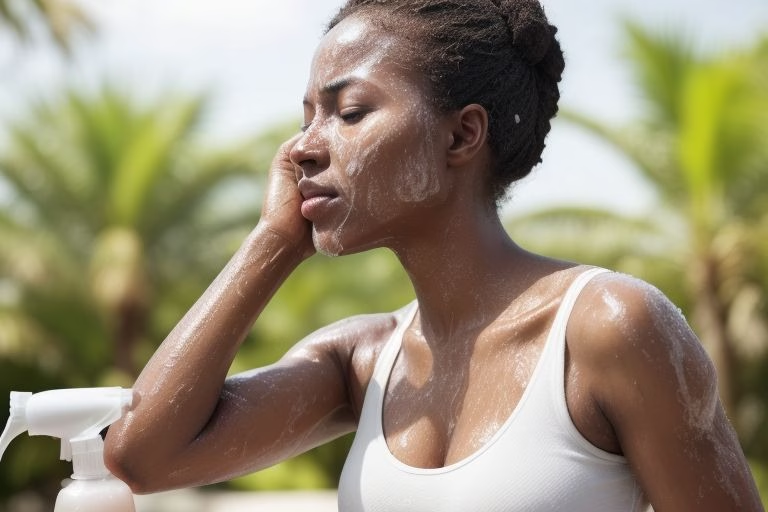What Is Heat Rash and Why It Happens?
If you’ve ever dealt with heat rash, you know how annoying and uncomfortable it can be—especially during the summer months. For African American skin, heat rash can appear a little differently, and understanding its unique presentation is key to managing and preventing it.
In this guide, we’ll explore what heat rash looks like on African American skin, why it happens, and the best ways to treat and prevent it.
What Does Heat Rash Look Like on African American Skin?
Heat rash, also known as miliaria, occurs when sweat ducts become blocked. This leads to small, itchy bumps or blisters that can cause irritation.
Common Signs on Darker Skin Tones:
- Tiny red or skin-colored bumps that may blend with deeper skin tones.
- Shiny or raised areas on the affected skin.
- Itchy, prickly sensations, especially in areas where sweat accumulates (e.g., underarms, neck, or chest).
- In some cases, dark spots may linger after the rash heals, a condition known as post-inflammatory hyperpigmentation (PIH).
Pro Tip: Use a mirror or take photos in natural light to spot subtle changes on your skin.
What Causes Heat Rash in African American Skin?
Several factors contribute to heat rash, including:
- Hot and Humid Weather: Sweat gets trapped under the skin.
- Tight Clothing: Fabrics that don’t breathe can worsen the issue.
- Heavy Moisturizers or Oils: Products that block pores may lead to sweat buildup.
- Physical Activity: Prolonged sweating during workouts or outdoor activities.
Top Remedies for Heat Rash Relief
Here’s how you can soothe heat rash and prevent further irritation:
1. Cool Down Quickly
- Take a cool shower or bath to lower your skin temperature.
- Use a cold compress on the affected area for instant relief.
2. Choose Lightweight, Breathable Fabrics
- Wear loose clothing made of cotton or moisture-wicking materials.
- Avoid synthetic fabrics like polyester that can trap sweat.
3. Use Anti-Itch Lotions
- Look for products with calamine lotion or hydrocortisone to calm itching.
- Avoid heavy, oil-based creams that can clog pores.
4. Apply Natural Remedies
- Aloe Vera Gel: Provides a cooling effect and reduces inflammation.
- Baking Soda Paste: Mix baking soda with water and apply it to the rash to ease irritation.
5. Keep the Area Dry
- Use a light talcum powder or cornstarch to absorb excess moisture.
- Avoid baby powder with harmful ingredients like talc.
How to Prevent Heat Rash on African American Skin
Prevention is always better than cure! Here’s how to stay ahead of heat rash:
1. Stay Cool
- Use a fan or air conditioning during hot weather.
- Avoid prolonged exposure to heat and humidity.
2. Adjust Your Skincare Routine
- Choose lightweight, water-based moisturizers instead of heavy oils.
- Exfoliate gently to avoid clogged pores, but don’t overdo it.
3. Avoid Overheating
- Take breaks in the shade if you’re outdoors.
- Stay hydrated to regulate your body temperature.
When to See a Doctor
While most heat rashes resolve on their own, consult a dermatologist if:
- The rash doesn’t improve after a few days.
- You notice signs of infection like pus, swelling, or fever.
- The itching becomes unbearable.
Common Myths About Heat Rash on African American Skin
Let’s bust some myths:
- “Heat rash is only a summer issue.” Nope! It can happen year-round, especially in warm environments.
- “All moisturizers are good for heat rash.” Wrong! Heavy, oil-based products can make it worse.
FAQs: Your Heat Rash Questions Answered
1. Can heat rash cause dark spots on African American skin?
Yes, heat rash can sometimes lead to post-inflammatory hyperpigmentation. This is temporary and can fade with time or gentle treatments like vitamin C serums.
2. Is heat rash contagious?
No, heat rash is not contagious. It’s caused by trapped sweat, not an infection.
3. Are there specific products for African American skin?
Yes! Look for gentle, fragrance-free products designed for sensitive skin. Brands like CeraVe or Aveeno often have options suitable for all skin tones.
Say Goodbye to Heat Rash!
Dealing with heat rash on African American skin doesn’t have to be a struggle. By understanding its unique presentation and taking proactive steps, you can prevent and treat it effectively.
Have your own tips or remedies for heat rash? Share them in the comments below!
